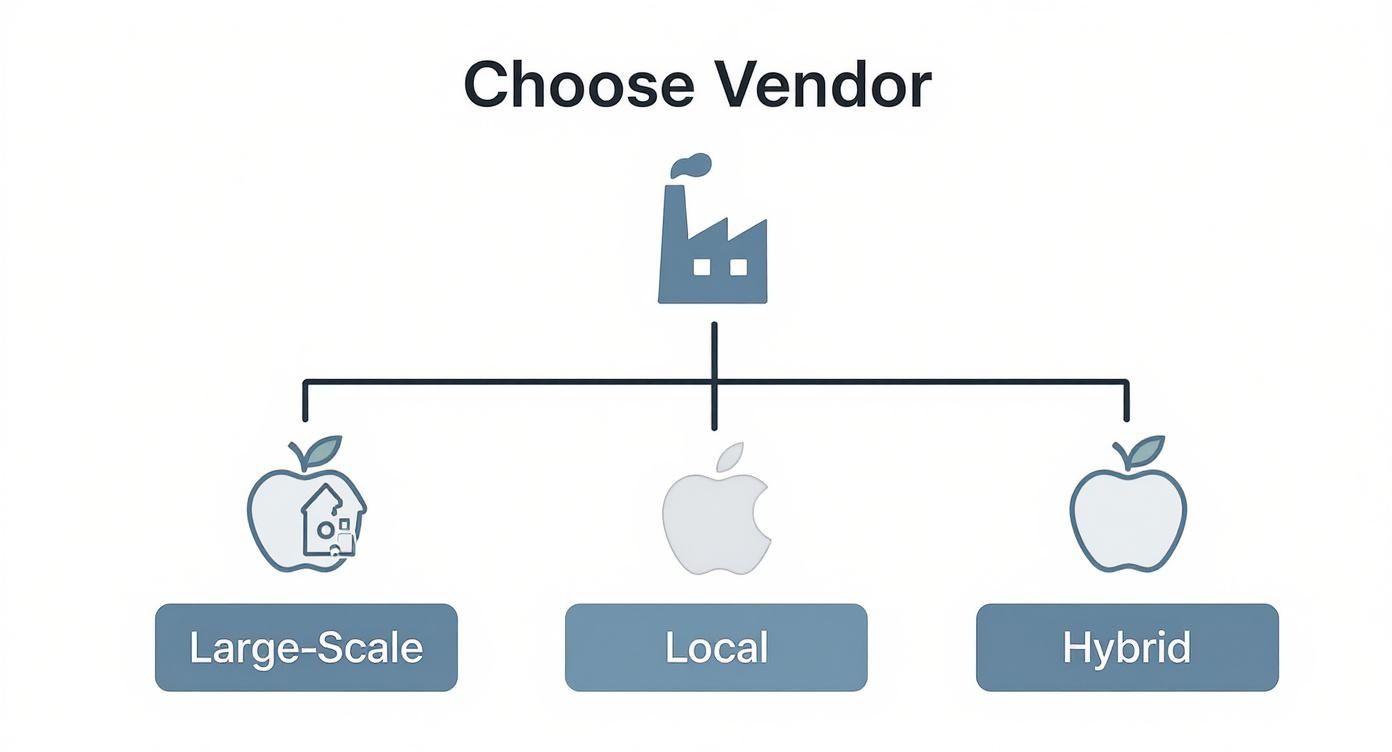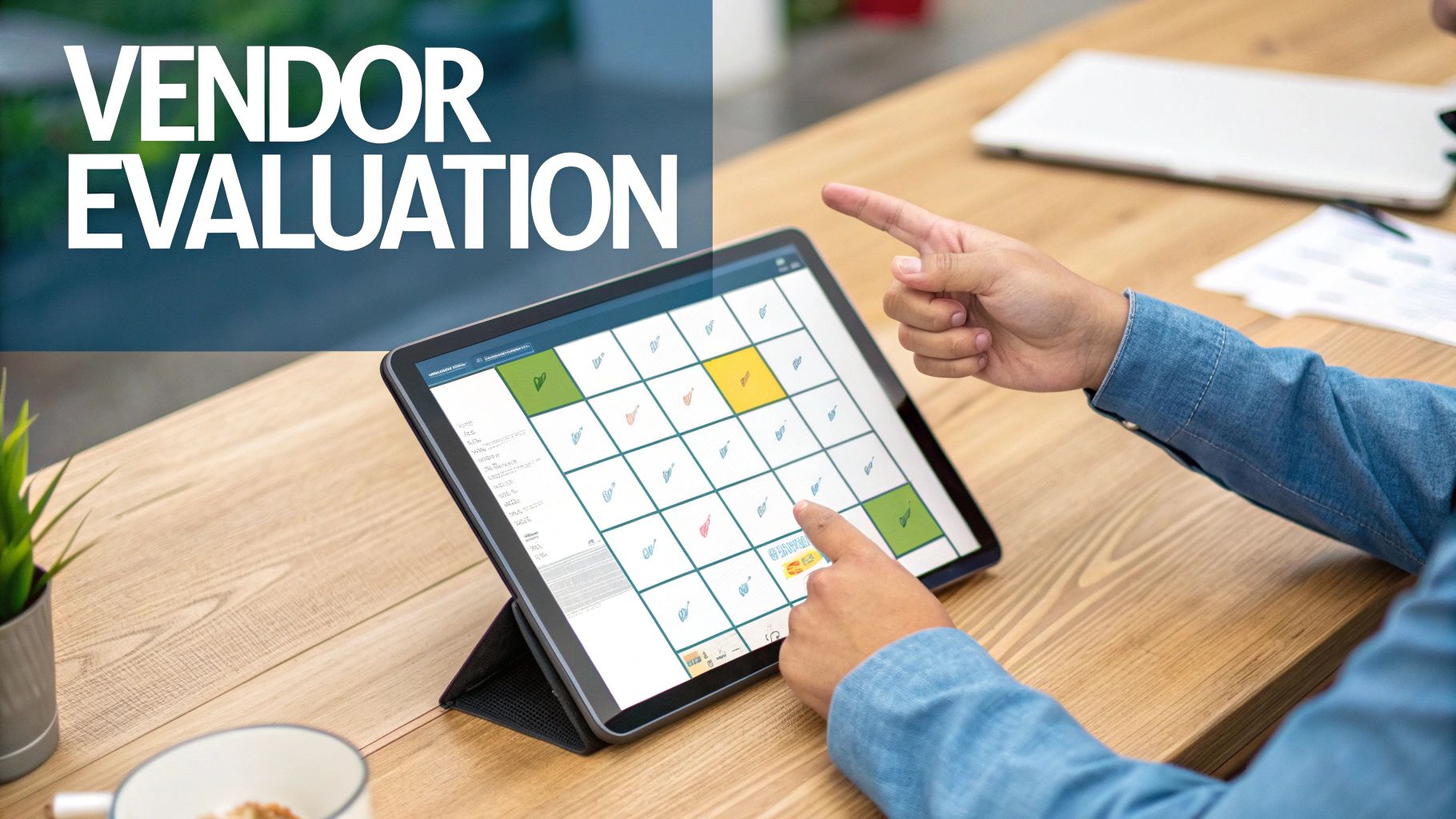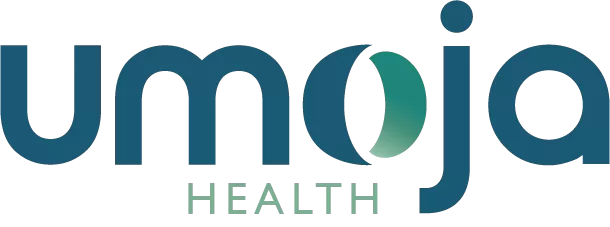Choosing the right school breakfast program vendors is a critical decision, balancing student nutrition, operational realities, and strict federal compliance. The best vendors aren’t just suppliers; they’re strategic partners who help your district navigate complex reimbursement systems while delivering appealing, healthy meals that boost student participation. It all comes down to finding a partner who understands your community’s unique needs, whether you’re in a dense urban center or managing rural non-congregate service.
Navigating the School Breakfast Vendor Landscape
Selecting a vendor for your school breakfast program goes far beyond comparing price lists. It demands a thorough analysis of different program models and their operational feasibility. The vendor landscape is incredibly varied, from massive national distributors specializing in processed, shelf-stable items to local and regional suppliers championing fresh, farm-to-school ingredients. Each approach has significant implications for your budget, staffing, and student equity.
The scale of these programs is immense. The School Breakfast Program (SBP) is a cornerstone of child nutrition, operating in over 93,000 schools and serving more than 15.5 million children on an average school day during the 2023–2024 school year. A major driver for this growth has been the expansion of the Community Eligibility Provision (CEP), which simplifies the process for schools in high-need areas to offer free meals to all students. You can learn more about the operational requirements of federal child nutrition programs and what it takes to run them effectively.
Contrasting Vendor Models: Processed vs. Fresh
The fundamental choice often boils down to two main avenues: processed/shelf-stable versus fresh-focused models. Processed models offer consistency, extended shelf life, and simplified logistics, making them an ideal fit for districts with limited kitchen staff, storage capacity, or a wide geographic area to cover. Conversely, fresh models prioritize superior nutritional quality and local sourcing but demand robust cold-chain management and more significant labor investment. A vendor’s reliability and cost-effectiveness often depend on their internal expertise, especially their strategies for optimizing restaurant supply chain solutions.
From Umoja’s Perspective: A true partnership extends beyond logistics. We’ve seen that creative outreach—like facilitating student taste-testing panels and actively incorporating menu feedback—is a game-changer for participation. Your vendor should be a proactive collaborator, helping you design a program that reduces food waste and builds community buy-in.
| Criteria | Processed/Shelf-Stable Model | Fresh-Focused Model |
|---|---|---|
| Logistics | Simpler; minimal need for cold storage and daily deliveries. | More complex; requires robust cold-chain management and frequent deliveries. |
| Labor Needs | Lower; grab-and-go or pre-packaged items require minimal prep. | Higher; requires staff for preparation, cooking, and serving. |
| Nutritional Impact | Consistent but often relies on fortified foods; less variety of whole foods. | Higher nutritional quality with fresh fruits, vegetables, and whole grains. |
| Student Equity | Easy to standardize, ensuring consistent meal access across all schools. | Can be tailored to local tastes but may be harder to scale consistently. |
Comparing Fresh vs. Processed Vendor Models
Choosing between a vendor specializing in fresh food and one focused on processed, shelf-stable items is one of the most critical decisions for your school breakfast program. This choice impacts everything from your budget and staffing to student satisfaction and the nutritional benefits they receive. It’s not about one model being inherently better; the right fit depends entirely on your district’s specific capacity, goals, and community needs.
A processed model, built around shelf-stable items, offers operational simplicity. For districts juggling limited kitchen space, a small staff, or a vast geographic area, this approach provides consistency and reduces the daily burden of food preparation. These vendors deliver pre-packaged, grab-and-go meals designed to meet federal reimbursement guidelines with minimal hassle, making compliance straightforward.
On the other hand, a fresh-focused model elevates nutritional quality and student engagement. Partnering with vendors who prioritize fresh fruits, vegetables, and whole grains can significantly enhance the health impact of your program. This model is well-suited for districts with central kitchens, established farm-to-school initiatives, or a community that values local sourcing.
Key Evaluation Criteria
To make an informed decision, you must evaluate potential school breakfast program vendors through several critical lenses. Each criterion helps reveal the true cost and benefit of a vendor’s approach.
- Nutritional Impact: A fresh model generally delivers higher nutritional value from whole foods. A processed model ensures consistent, USDA-compliant nutrition but may rely more heavily on fortified ingredients.
- Logistical Complexity: Processed vendors simplify storage and distribution, often eliminating the need for extensive cold-chain management. Fresh models require strict temperature controls and more frequent deliveries.
- Labor and Operations: Fresh food requires staff for preparation and service, increasing labor costs. Processed meals minimize labor, often only needing staff for distribution and oversight.
- Equity and Access: Processed models make it easier to standardize meals across all schools, helping ensure equitable access to similar nutrition regardless of location or school infrastructure.
This decision tree provides a visual guide for selecting the best vendor model based on your district’s core capabilities.

As the graphic illustrates, factors like program scale and local sourcing capacity will naturally guide you toward a large-scale, local, or hybrid vendor partnership.
Integrating with Federal Reimbursement Systems
Regardless of the model chosen, the vendor must integrate flawlessly with federal reimbursement systems like the School Breakfast Program (SBP). Their ability to provide compliant meal patterns, accurate documentation, and adhere to “Buy American” provisions is non-negotiable. Processed-food vendors typically excel in this area, offering pre-approved menus that simplify reporting.
When vetting fresh-food vendors, you must confirm they understand and can meet these stringent documentation standards. Request sample menus and production records that prove their compliance capabilities. A true partner helps you navigate this complexity, not add to it. For those managing non-congregate or multi-day meals, understanding the specifics of compliant kitting programs is crucial for smooth operations.
From Umoja’s Perspective: We often see operational pitfalls arise when contracts lack clarity on substitutions or menu changes. A vendor should proactively offer compliant alternatives when supply chain issues occur, ensuring your reimbursement is never at risk. This flexibility and foresight are hallmarks of a true strategic partner.
A Sample Evaluation Rubric
To move beyond anecdotal evidence and make an objective choice, a structured evaluation rubric is essential. It provides a framework for a fair, data-driven comparison of different school breakfast program vendors.
| Criterion | Processed Model (Score 1-5) | Fresh Model (Score 1-5) | Key Considerations for Your District |
|---|---|---|---|
| Logistical Simplicity | 5 | 2 | Do you have adequate cold storage and staffing for daily prep? |
| Initial Student Appeal | 4 | 5 | How important are menu variety and fresh ingredients to your students? |
| Food Waste Potential | 3 | 3 | Shelf-stable has a longer life, but fresh can be used in other meals. |
| Nutritional Density | 3 | 5 | What are the primary nutritional goals of your program? |
| Per-Meal Cost | 4 | 2 | How does each model fit within your per-meal budget constraints? |
Ultimately, the best model is the one that aligns with your district’s operational reality. By carefully weighing these factors, you can select a vendor that not only meets federal requirements but truly serves the needs of your students.
How to Build a Compliant and Effective RFP

A well-constructed Request for Proposal (RFP) is your single most powerful tool for attracting high-quality school breakfast program vendors. It sets the foundation for a program built on compliance and clarity from the very start. Think of it less as a simple request for pricing and more as a detailed blueprint communicating your district’s specific needs, operational realities, and non-negotiable federal requirements.
A vague RFP inevitably leads to weak proposals. A precise one, on the other hand, attracts capable partners who understand the assignment from day one. The goal is to eliminate every bit of ambiguity. Your RFP should spell out every expectation, from the nutritional components of a breakfast kit to the exact delivery window for a rural non-congregate site. This level of detail empowers vendors to submit realistic proposals and allows your team to make a true apples-to-apples comparison.
Core Components of a Compliant RFP
To build an RFP that guarantees both compliance and operational success, you must embed specific, legally sound language directly into the document. These aren’t optional suggestions; they’re essential for securing federal reimbursements and protecting your program from day one.
Your RFP must include clauses that require vendors to adhere strictly to the latest USDA meal pattern requirements. You’ll need to specify the required components—like grains, protein, fruit, and milk—and their minimum portion sizes for the age group you serve.
The Buy American provision is another critical compliance point you can’t afford to overlook. Your RFP language must mandate that vendors supply domestically grown and processed foods to the maximum extent practicable. This isn’t just about supporting the national economy; it’s a key requirement of federal procurement law.
Umoja’s Expert Insight: We often see districts struggle with RFPs that don’t account for logistical complexities. Be explicit. If you need temperature-monitored deliveries for milk in a rural non-congregate model, state the required temperature range and the documentation you expect. Specificity prevents costly misunderstandings down the road.
Sample Language for Critical Clauses
Drafting precise language is where the rubber meets the road. General statements such as ‘must meet USDA guidelines’ are insufficient; specific language referencing the relevant Code of Federal Regulations (CFR), such as ‘meals must comply with the current SBP meal pattern outlined in 7 CFR Part 220,’ should be used. You need to provide clear, actionable instructions that leave no room for interpretation.
Here are a few examples of how to structure these clauses for maximum clarity:
- USDA Meal Pattern Adherence: “The vendor must provide meals that comply with the current School Breakfast Program (SBP) meal pattern requirements outlined in 7 CFR Part 220. All proposals must include sample weekly menus with detailed component breakdowns and nutritional information.”
- Milk Inclusion Clause: “All breakfast meals must include one 8-ounce serving of fat-free or low-fat (1%) fluid milk. The vendor must describe their cold-chain management process to ensure milk is delivered and maintained at or below 41°F.”
- Buy American Provision: “In accordance with the Buy American provision, the vendor must provide food products that are produced and processed in the United States using at least 51% domestic agricultural commodities, in accordance with the Buy American provision (7 CFR 210.21(d)). The vendor must provide documentation of compliance upon request.”
Defining Specifications for Diverse Delivery Models
Today’s breakfast programs often serve students far beyond the cafeteria. Your RFP must define the unique requirements for models like rural non-congregate service or home delivery, which present their own distinct logistical challenges for school breakfast program vendors. For those navigating complex procurement, understanding how to partner with experienced organizations can be a game-changer. You can explore our work with government agencies to see how these strategic partnerships can streamline the effort.
When outlining your specifications, think through the entire process from the vendor’s warehouse to the student’s hands. This means getting into the weeds on details like kitting, labeling, and third-party logistics (3PL) integration. For instance, specify if multi-day meal kits need to be assembled in a particular order or if individual meals must be labeled with allergen information and heating instructions. For home delivery, be sure to define your expectations for delivery windows, parent communication, and what happens after a failed delivery attempt.
Creating Your Vendor Evaluation Rubric
Once your detailed RFP is out the door, the real work begins. Moving from proposals to a final decision requires a structured, objective way to compare your options. This is where a well-defined evaluation rubric becomes your most critical tool for picking the right school breakfast program vendor.
A scoring system takes you beyond just comparing prices. It forces a more nuanced look at a vendor’s capabilities, their reliability, and what kind of partner they’ll truly be. By assigning different weights to the criteria that matter most—whether that’s nutritional quality, logistical precision, or ensuring equity across your schools—you can make a fair and defensible choice. This data-driven method ensures you’re not just hiring a supplier, but a partner who can handle the complexities of your program.

Analyzing Vendors and Program Models
Your rubric has to reflect the real-world operational differences between vendors. For example, a major point of contrast is between vendors offering processed, shelf-stable meals versus those centered on fresh ingredients. One isn’t automatically better; they simply serve different needs.
A processed meal model offers logistical simplicity, which is a huge advantage for districts with limited staff or cold storage. On the other hand, a fresh model delivers higher nutritional quality but requires airtight cold-chain management and more hands-on involvement from your team. Your rubric must be designed to score these trade-offs based on your district’s actual capacity.
And, of course, any vendor you consider must be able to plug seamlessly into federal reimbursement systems like the School Breakfast Program (SBP). Their ability to deliver meticulous documentation for meal patterns and prove adherence to the Buy American provision isn’t just a nice-to-have—it’s non-negotiable.
Key Evaluation Criteria
A solid rubric is built on clear, measurable criteria. We recommend breaking your evaluation into three main domains: nutritional impact, equity, and logistics. This approach guarantees you’re looking at each proposal from all the important angles.
- Nutritional Impact: How well do their sample menus align with your district’s health and wellness goals? Look for variety, ingredient quality, and their willingness to exceed minimum USDA standards.
- Equity and Accessibility: Can the vendor accommodate diverse dietary needs, including allergies and cultural preferences? Assess their experience serving schools with high Community Eligibility Provision (CEP) participation and their strategies for ensuring every student receives an appealing meal.
- Logistical Reliability: This is the operational backbone. It covers everything from on-time delivery records and cold-chain integrity to their inventory management systems and communication protocols during disruptions.
Umoja’s Perspective: From our experience, a vendor’s inability to adapt is a primary source of operational failure. During your evaluation, present them with real-world scenarios. Ask, “What is your protocol if a key ingredient is suddenly unavailable due to a supply chain disruption?” A strong partner will have a clear, compliant substitution plan ready, protecting your reimbursement and ensuring students are fed without interruption.
Sample Evaluation Rubric
To make this practical, a weighted rubric helps you focus on what’s most important to your district. By assigning a percentage of the total score to each criterion, you create a scoring system that is both transparent and objective. As you get more sophisticated with your process, using a dedicated vendor management template can help standardize how you assess vendors across the board.
The table below is a starting point. Your team should feel empowered to adjust the weightings to match your district’s specific needs. For instance, a rural district with long delivery routes might give a heavier weight to logistical reliability, and that’s exactly what they should do.
Sample Vendor Evaluation Rubric for School Breakfast Programs
| Evaluation Criterion | Description of Criterion | Weighting (e.g., % of Total Score) | Scoring Scale (1-5) |
|---|---|---|---|
| Nutritional Quality & Impact | Adherence to USDA meal patterns, use of whole grains, fresh produce, and low-sugar options. | 30% | 1 (Fails to meet) – 5 (Exceeds all) |
| Logistical Capability & Reliability | On-time delivery record, cold-chain management, inventory systems, and communication protocols. | 25% | 1 (Unreliable) – 5 (Flawless record) |
| Equity & Customization | Ability to meet special dietary needs, cultural preferences, and support for CEP schools. | 20% | 1 (Limited options) – 5 (Highly flexible) |
| Program Cost | Per-meal cost, delivery fees, and any additional administrative charges. | 15% | 1 (High cost) – 5 (Most competitive) |
| Experience & References | Proven track record with similar school districts and positive client references. | 10% | 1 (No experience) – 5 (Excellent references) |
Ultimately, a rubric like this transforms a subjective decision into an objective, data-backed choice, giving you confidence that you’ve selected the best possible partner for your students.
Avoiding Common Pitfalls in Vendor Partnerships
Choosing a school breakfast program vendor is just step one. The real work—and where programs either soar or stumble—is in nurturing that relationship long after the contract is signed. A strong partnership is built on rock-solid, crystal-clear expectations from the get-go. Too often, we see districts fall into preventable traps that put everything from meal quality and student participation to federal reimbursements at risk.
Most of these headaches boil down to ambiguity. Fuzzy contract language about menu substitutions, delivery windows, or quality control is a recipe for operational chaos. When a vendor relationship goes south, it’s almost always because the initial agreement never defined what success actually looks like in concrete, measurable terms.
This level of operational clarity has never been more critical. Across the United States, over 93,000 schools depend on a network of vendors to serve breakfast to 15.5 million students every single day. As of the 2023–2024 school year, approximately 60% of schools offer universal free meals, up from 18% in 2014, reflecting a major policy shift and greater access for students. You can get a better sense of the scale of these operations in the School Nutrition Association’s 2024 report.
Setting Clear KPIs for Success
To sidestep misunderstandings, your partnership needs to be built on a foundation of clear Key Performance Indicators (KPIs). These aren’t just buzzwords; they are the metrics that turn subjective hopes into objective goals that both you and your vendor can track.
- On-Time Delivery Rate: Be specific about what “on-time” means. Is it a 30-minute window? An exact time? A KPI of 98% or higher is a perfectly reasonable benchmark.
- Order Accuracy: This should track the percentage of orders delivered perfectly—no missing items, no wrong quantities. You should be aiming for 99% accuracy.
- Meal Quality Score: Create a simple scoring system for food quality using feedback from cafeteria staff and, most importantly, students. This can be as simple as spot checks for temperature, freshness, and how the food is presented.
Another major failure point is poor vendor onboarding. A new vendor can’t just be thrown into the deep end and expected to swim. A structured onboarding process, complete with introductions to key school staff and walk-throughs of every delivery site, paves the way for a smooth, lasting relationship.
Umoja’s Perspective on Creative Outreach and Operational Pitfalls
A truly great vendor does more than just drop off boxes of food; they become a genuine partner in boosting student participation and satisfaction. This is where creative outreach can make a world of difference.
From our experience at Umoja, the most successful programs treat students as valued customers. Many vendors recommend collaborative approaches, such as facilitating student taste tests and menu feedback collection, to boost participation and satisfaction. Giving students a voice not only improves the menu but also fosters a sense of ownership that dramatically increases participation.
For example, a vendor can provide sample-sized portions of new menu items for students to try during lunch. A simple QR code survey can gather immediate feedback, arming you with real data to guide what you serve next. This kind of proactive partnership transforms a transactional arrangement into a collaborative one, where everyone is working toward the same goals.
Proactive Solutions to Common Problems
The best way to solve problems is to anticipate them before they happen. Vague contract language, especially around substitutions, is a classic source of friction. Your contract must spell out the exact protocol for when a specified food item isn’t available. It should require the vendor to provide a compliant, nutritionally equivalent alternative—but only after getting your approval first.
Likewise, not having clear lines of communication can quickly escalate minor issues into full-blown crises. Designate a single point of contact for both the district and the vendor. Set up regular check-in meetings—maybe weekly at first, then shifting to monthly—to review KPIs, tackle challenges, and plan for upcoming menu changes. This steady dialogue builds trust and keeps everyone on the same page.
Your Top Questions About School Breakfast Vendors Answered
When you’re navigating the world of school breakfast vendors, a lot of the same questions tend to pop up for procurement teams. Getting straight answers is the only way to make a confident choice that actually helps your program thrive. Let’s dig into the most common sticking points and get you some clear, actionable guidance.
How Do We Even Start Finding Qualified Vendors?
The best first step is always an internal one: clearly define what your program actually needs. Think about the nitty-gritty details—are you serving fresh meals or shelf-stable kits? What are the delivery logistics for every single site? Do you have specific dietary or cultural needs to meet?
Once you have that picture, sending out a Request for Information (RFI) is a great way to see who’s out there in your region. It’s a low-commitment way to identify potential partners before you dive into writing a full-blown Request for Proposal (RFP). Another invaluable tactic? Talk to neighboring school districts. Their real-world experience can give you an honest look at a vendor’s reliability and overall partnership style, which can save you a world of headaches down the road.
How Can We Be Sure a Vendor Is USDA Compliant?
You have to build compliance directly into your procurement documents from day one. Your RFP and, most importantly, the final contract must spell out every USDA meal pattern and nutritional requirement in detail. This absolutely includes the critical Buy American provision. Don’t just ask if they are compliant; your contract needs to demand proof.
During your evaluation, ask for sample menus and their corresponding nutritional data. But the real key is building ongoing accountability into your contract. Make sure you include clauses that require the vendor to provide periodic compliance audits and documentation. This turns them from a simple supplier into a reliable partner in meeting federal standards.
What’s the Best Way to Evaluate Vendors Beyond Just the Price Tag?
While budget is always a reality, the lowest bid rarely equals the best value for your students. The most effective tool for a fair and balanced evaluation is a weighted scoring rubric. This method lets you assign more importance to the criteria that matter most to your district’s success, like logistical muscle, food quality, and a commitment to equity.
Umoja’s Perspective: A vendor’s potential as a long-term partner often shines through in their approach to equity. Ask them how they handle diverse dietary needs or support schools with high CEP participation. Their response will tell you if they’re just a supplier or a true partner who is invested in helping you boost student participation and satisfaction.
Always check their track record with districts of a similar size and complexity to your own. When you look beyond the price, you can find a school breakfast program vendor that will actually help you achieve your bigger goals.
At Umoja Health, we specialize in creating compliant, culturally connected food solutions for government agencies, schools, and community organizations nationwide. We help you navigate the complexities of federal nutrition programs to ensure every meal counts. Discover how our scalable kitting and logistics services can support your mission at https://umojahealth.com.

